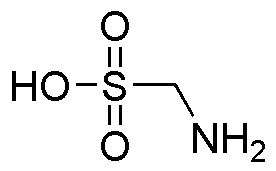Aminomethanesulfonic acid is widely utilized in research focused on:
- Biotechnology: It serves as a buffering agent in biological and biochemical experiments, helping to maintain stable pH levels, which is crucial for enzyme activity and cell culture.
- Pharmaceuticals: This compound is used in drug formulation processes, enhancing the solubility and stability of active ingredients, which can improve the efficacy of medications.
- Analytical Chemistry: It acts as a reagent in various analytical techniques, including chromatography and spectrophotometry, aiding in the accurate detection and quantification of substances.
- Cosmetics: Aminomethanesulfonic acid is incorporated into skincare products for its moisturizing properties, helping to improve skin hydration and texture.
- Agriculture: It is applied in the formulation of fertilizers and soil conditioners, promoting nutrient availability and enhancing plant growth.
General Information
Properties
Safety and Regulations
Applications
Aminomethanesulfonic acid is widely utilized in research focused on:
- Biotechnology: It serves as a buffering agent in biological and biochemical experiments, helping to maintain stable pH levels, which is crucial for enzyme activity and cell culture.
- Pharmaceuticals: This compound is used in drug formulation processes, enhancing the solubility and stability of active ingredients, which can improve the efficacy of medications.
- Analytical Chemistry: It acts as a reagent in various analytical techniques, including chromatography and spectrophotometry, aiding in the accurate detection and quantification of substances.
- Cosmetics: Aminomethanesulfonic acid is incorporated into skincare products for its moisturizing properties, helping to improve skin hydration and texture.
- Agriculture: It is applied in the formulation of fertilizers and soil conditioners, promoting nutrient availability and enhancing plant growth.
Documents
Safety Data Sheets (SDS)
The SDS provides comprehensive safety information on handling, storage, and disposal of the product.
Product Specification (PS)
The PS provides a comprehensive breakdown of the product’s properties, including chemical composition, physical state, purity, and storage requirements. It also details acceptable quality ranges and the product's intended applications.
Certificates of Analysis (COA)
Search for Certificates of Analysis (COA) by entering the products Lot Number. Lot and Batch Numbers can be found on a product’s label following the words ‘Lot’ or ‘Batch’.
*Catalog Number
*Lot Number
Certificates Of Origin (COO)
This COO confirms the country where the product was manufactured, and also details the materials and components used in it and whether it is derived from natural, synthetic, or other specific sources. This certificate may be required for customs, trade, and regulatory compliance.
*Catalog Number
*Lot Number
Safety Data Sheets (SDS)
The SDS provides comprehensive safety information on handling, storage, and disposal of the product.
DownloadProduct Specification (PS)
The PS provides a comprehensive breakdown of the product’s properties, including chemical composition, physical state, purity, and storage requirements. It also details acceptable quality ranges and the product's intended applications.
DownloadCertificates of Analysis (COA)
Search for Certificates of Analysis (COA) by entering the products Lot Number. Lot and Batch Numbers can be found on a product’s label following the words ‘Lot’ or ‘Batch’.
*Catalog Number
*Lot Number
Certificates Of Origin (COO)
This COO confirms the country where the product was manufactured, and also details the materials and components used in it and whether it is derived from natural, synthetic, or other specific sources. This certificate may be required for customs, trade, and regulatory compliance.


